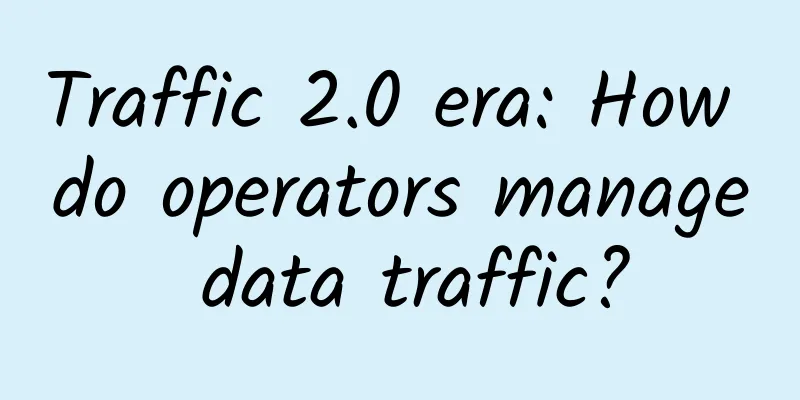Traffic 2.0 era: How do operators manage data traffic?

|
1. China Telecom’s “Flow Treasure” and China Unicom’s “Flow Bank” On May 13, 2014, China Telecom launched "Flow Treasure" for the first time. Flow Treasure is an Internet traffic management platform with traffic coins as the core. Flow Treasure uses tasks and Niu coins to build a bridge between users and partners, exploring a new model of traffic cooperation. In this model, merchants can purchase traffic from operators, and then let users complete tasks through activities to obtain traffic. After users obtain traffic by completing tasks, they can convert the traffic into Niu coins on the Flow Treasure platform, and use Niu coins to achieve preferential policies such as phone bill recharge. Of course, you can also use the traffic for your own use or give it to others. On November 25, 2014, China Unicom officially launched the "wo+ Traffic Bank" at the Mobile Internet Traffic Innovation Summit organized by Renmin University. The essence of Traffic Bank is similar to "Traffic Treasure". Users can access, manage, and trade traffic on the Traffic Bank platform to gain better experience and fun. Related news mentioned that the launch of Traffic Bank is not only an important product promotion for Unicom to step out of the pipeline business positioning, but also a favorable opportunity to build a virtual currency platform and cooperate with more service providers. At the press conference, Unicom mentioned the concept of the traffic 2.0 era. As traffic management crosses from 1.0 to 2.0, Unicom hopes to open a new era of traffic and marketing through Traffic Bank. Under full traffic, the competition between operators and OTT businesses is destined to be a difficult road. A report once pointed out that no matter which path operators choose, they must remember to take advantage of their inherent advantages, which are based on four pillars: customer relationships and customer maintenance infrastructure, billing cycles and trust established between operators and customers, usage data analysis results obtained from call and location data, and unique identification numbers that bind users to operators. Perhaps "Flow Treasure" and "Flow Bank" tell us that there is another pillar, that is, "Flow Portal". Whether it is China Mobile's attempt at "backward unified payment", or this year's "Flow Treasure", "Flow Bank" and China Mobile's possible follow-up products in the future (China Mobile cannot fail to do so), they are all a new traffic management model. In order to better understand "Flow Treasure" and "Flow Bank", the author borrows the concept of Traffic 2.0 proposed by China Unicom's press conference to summarize the characteristics of the current and past two different traffic eras, and hopes to clarify the direction and measures of traffic management in the new era. II. Characteristics and operational requirements of different traffic eras (I) Review of Traffic 1.0 Characteristics and Operational Measures Traffic 1.0 and 2.0 are just qualitative terms. If we must make a quantitative distinction, from the perspective of operators, by comparing the business and customer characteristics of domestic and foreign operators, we can draw some differences in basic indicators. The basic characteristics of the Traffic 1.0 era are as follows: DoU (data traffic per user) is less than 500MB, 3G coverage is less than 90%, traffic volume continues to grow (the growth rate may eventually become smaller and smaller, user MOU/ARPU may decline slightly, but the total traffic volume is growing), and the penetration rate of smart terminals is less than 50%. Landmark events: GPRS, EDGE, 3G. For operators, the main business goal in the Traffic 1.0 era is to cultivate and popularize traffic applications and continuously increase the average traffic per household and traffic revenue. Looking back, there are usually the following four traffic management measures. First, the continuous optimization of traffic charges. For example, the traffic share in the contract package is gradually increased, the price of pure traffic package packages continues to drop, and the superimposed traffic packages can be ordered multiple times in the same month. The author believes that the superimposed traffic package is a typical example. The reason is that Tencent found that the original mobile QQ users showed a typical decrease in activity at the end of the month, and the use of the traffic in the package in the month was an important influencing factor. In order to meet the traffic needs of customers after exceeding the package (the standard tariffs at the time were usually more expensive, and the difference between the internal and external tariffs of the package was huge), superimposed traffic packages (such as 1 yuan or 2 yuan for 5MB) came into being and developed rapidly in practice. Second, the traffic service capabilities are constantly improving. When GPRS was first activated, customers had to take the initiative to go to the business hall to accept it because they were worried that customers would complain about charges without knowing it. Later, mobile Internet access gradually became a basic function and the system was activated by default. However, according to relevant requirements, customers were reminded of the charges when they first went online. When customers are accustomed to frequent mobile Internet access, the first charge reminder is basically useless. When customers have an increasingly strong demand for control over the progress of traffic usage, various service measures or service products such as monthly reminders, real-time viewing of traffic progress, and traffic assistants have emerged. Among them, traffic assistants have become a good link for operators to connect and serve customers. Third, through content (own or third-party), we continuously cultivate customers' mobile Internet habits. For example, China Mobile's original video, game, reading, surfing assistant and other self-owned services are free of data charges, and China Unicom and WeChat jointly launched the WeChat data package. Fourth, popularize smart terminals. The data traffic of smart terminals is very different from that of non-smart terminals. Even if they are both smart terminals, there are obvious differences between different operating systems and brands. According to current data, the average traffic of Apple phones is 6 times that of Nokia. It should be said that in the 3G era, subsidies from operators played a significant role in promoting the development of smart terminals. (II) Traffic 2.0 characteristics and business objectives The rapid development of 3G, especially the official commercial use of 4G, has brought the traffic 1.0 era to a climax. A large number of OTT applications have driven traffic demand and popularized mobile traffic applications. At the same time, operators' traditional short message and voice revenues have begun to decline due to being replaced, and traffic revenue has become the main source of revenue growth for operators. Traffic, to a certain extent, means all services. All of these indicate that operators' traffic management has entered a new era. The basic characteristics of the Traffic 2.0 era are as follows: DoU greater than 500MB, 3G 4G coverage greater than 90%, call volume starting to decline (call revenue may have already started to decline), and smart terminal penetration rate greater than 50%. Milestones: 4G, WeChat phonebook, and converged communications. By sorting out the changes in the revenue structure and customer characteristics of domestic and foreign operators, we can find that, referring to the above standards, operators in developed countries abroad basically entered the traffic 2.0 era in 2010, and domestic operators basically entered the traffic 2.0 era in 2014, although the overall average monthly traffic of users did not reach 500MB. For operators, although increasing user traffic and stabilizing or improving user ARPU are the ultimate goals, from the perspective of specific measures, the business goals in the Traffic 2.0 era should be to meet a wider range of customer needs, operate traffic entrances (explicitness) and realize traffic value-added. In terms of customer needs, we should not only pay attention to individual customer needs, but also to the needs of mobile Internet enterprise users; we should not only pay attention to how much customers use, but also pay attention to whether customers are happy with their use. When customer needs evolve from individual customers to mobile Internet enterprise customers, then simple forward general traffic can no longer meet the needs. For example, there are needs for backward traffic, directional traffic, and traffic distribution. One of the earliest examples is AT&T's provision of Toll Free Data for Amazon Kindle. When a customer downloads a book on Amazon Kindle, AT&T provides network connection, and the traffic for downloading the book is wholesaled to Amazon (paid by it). At the end of 2013, Guangdong Mobile cooperated with Alibaba. Guangdong customers can visit Alibaba's website with their mobile phones for free, and the traffic generated is uniformly paid to the mobile company by Alibaba at a wholesale price, just like the Kindle method. For details on the classification of traffic, please refer to my previous article "In the era of full traffic, how do operators deal with OTT?" In terms of traffic entrances, they are mainly explicit traffic entrances. Since all mobile Internet services need the traffic of operators to carry, operators have become the largest traffic entrances, which are theoretically larger than WeChat’s entrances. However, there is no carrier and no perception, because the ball is passed over the top. So in the era of traffic 2.0, should the ball that is passed over the top be retrieved? Traffic coins and traffic trading centers are explicit traffic entrances to some extent. Traffic monetization seems to be a magical thing at first glance, but if you think about it carefully, it is actually no different from the price cards and Q coins in society. The early stage of monetization is that it has use value (except for paper money issued by the state authority). Because of its use value, it has exchange value and can be exchanged for the required goods and services. Because of its exchange value, it has storage value, extending the current right of exchange to the future. These are all taught in political economy. Therefore, in addition to precious metals, rice and cloth have become important forms of currency in history. For example, in the middle and late Tang Dynasty, due to the internationalization of copper coins and personal wealth storage caused by trade, there was a serious shortage of circulating copper coins, and silk once became an important form of large-value currency. Why can't traffic be used? Since data traffic is the most important carrier for the development of mobile Internet, traffic has more reason to become currency. If there is currency, there should be a platform for purchase, transfer and transaction. If operators can issue traffic coins, they must provide such a platform for enterprises and individuals to purchase, give, trade and transfer. If individual and corporate customers log in to the trading platform to a certain amount, some publish tasks (marketing means), some receive tasks to earn traffic, and some conduct transactions (register transactions or exchange and recharge), wouldn't it create an opportunity to cooperate with more service providers through the virtual currency platform? Who can say that this is not another WeChat? If the previous measures are to meet customer needs, then operating traffic entrances is to create demand. For the three operators, they can all issue and operate traffic coins, and they can also open them to each other and third parties. Just like the United States issues dollars, Europe issues euros, and China issues RMB, the value of traffic coins will be different due to different customer scales (national GDP) and influence. Just like China also stores dollars, it is normal for traffic coins to be open to operator competitors, but the ultimate application of traffic coins can only be limited to their own networks. In terms of value-added, traffic big data is the only way to increase value, and it is also the way that best reflects value. Some provincial companies use integrated gateways to carry out "traffic reminders or guidance" based on mobile web pages. Because they use traffic hijacking technology, they can only be a channel to serve customers at most, and cannot be a way to increase value. Operators have a lot of valuable data. The full use of data such as number identity characteristics, consumption characteristics, non-traffic business (business with a certain scale), location trajectory, and traffic behavior records can better understand customer needs and have broad commercial value. The commercial value of traffic data is even greater, and it can only be reflected under big data technology. 3. How to manage data traffic in the era of traffic 2.0 1. Intelligently controllable broadband network is the foundation First of all, it is the mobile broadband network. It is meaningless to talk about intelligent management and control without the mobile broadband network. This is the case with the vigorous development of 4G network construction by various operators (especially China Mobile). The second is the distribution and guidance capabilities based on CDN. For high-traffic proprietary services such as video, CDN is used for distribution and guidance to improve the access experience. For high-traffic third-party services, IDC content operation and guidance can be used to optimize distribution, improve customer perception and network efficiency. The second is the perception capability based on DPI. Operators must understand where the traffic is going in order to manage traffic. Considering that the proportion of web traffic is gradually being replaced by APP applications, it is very necessary to perceive users, services, and terminals based on DPI, which is the basis for the application of traffic big data. Finally, there is the differentiated service guarantee capability based on PCC. Considering the recent heated debate in the United States about "network neutrality", although operators insist on differentiated service quality assurance, it may be difficult to actually implement it. (II) The billing model of separating quantity and fee is a guarantee Whether it is "Traffic Treasure" or "Traffic Bank", there are three forms for customers to trade traffic coins and exchange traffic, cash (or payment from the actual payer), traffic coins (virtual currency), and traffic (real available traffic). Before this, customers purchased and consumed traffic as one, that is, you cannot buy traffic and give it to others for use. Now it is possible, and its basis is "separation of quantity and fee". The original billing system BOSS only implements the first part (or synchronizes the results to BOSS through the interface). Customers purchase traffic coins through phone bills/cash/Alipay, etc., and the rest should be handed over to a separate platform (assuming it is a traffic trading platform) to implement. The billing function for backward traffic/directional traffic can also be implemented by the traffic trading platform. The traditional approach is to directly configure the backward traffic bureau data on the GGSN/PGW. When the configuration is completed, when the customer accesses the application corresponding to the specified IP/URL, the GGSN/PGW marks the original call bill from the SGSN traffic according to the bureau data configuration, such as marking it as free. After the BOSS summarizes the call bill, it does not charge the user. Of course, it can also be marked as a certain directional rate. However, such operations have limitations. Usually, an Internet application may have dozens or hundreds of IP/URLs (servers deployed in different regions), and the GGSN bureau data configuration is limited and needs to be configured separately in each province. Too much configuration will also affect the GGSN protocol conversion and routing efficiency. If the billing mark of traffic call bills is moved from GGSN to the traffic trading platform, it will be an important measure to solve the problem of backward and directional traffic billing in the long run. (III) Operating traffic entrances to aggregate traffic value In the early stage, many provincial companies of operators implemented real-time traffic reminder services through traffic assistants (SMS, web pages, clients), and monitored the usage of customer packages. Of course, there were also recommendations for packages and superimposed packages. Some companies also opened customer traffic usage information inquiries and package subscriptions to various mobile Internet application portals by encapsulating related interfaces. These are all typical business measures in the traffic 1.0 era, but they were not mentioned at the level of operating traffic entrances before, and were only regarded as a customer service method implemented separately in various provincial companies. In the 2.0 era, portal operations should be centralized and unified. As mentioned earlier, operating traffic coins and trading platforms is actually operating traffic portals. The effectiveness of portals mainly comes from the scale of users, the scale of partners, and influence. These can only be achieved under the premise of centralized and unified operation of the entire network. This is also the reason why China Telecom and China Unicom both operate through centralized and unified organizations. Traffic trading platforms can also encapsulate capabilities, which can be realized through other Internet applications. For example, users buy traffic red envelopes, generate links through red envelopes, share the links to WeChat groups or Moments, and click on the links to grab and receive red envelopes. In essence, all operations are completed through the trading platform, but not all operations are necessarily reflected through the trading platform. (IV) Carry out big data cooperation to achieve value-added On November 27, an article was published on WeChat self-media, which talked about the opportunities of the operator big data industry chain. It mentioned that global operators have begun to prepare for the big data. According to the survey results of Informa Telecoms&Media, a telecommunications and media market research company in 2013, about 48% of the world's 120 operators are implementing big data services. The cost of big data services accounts for an average of 10% of the operator's total IT budget, and will rise to 23% in the next five years, becoming a strategic advantage for operators. In 2014, with the commercialization of 4G construction, domestic operators' data collection investment has increased significantly. The article mentioned that China Unicom's investment scale for data collection in the third phase of the 3G era was about 900 million yuan, and the investment scale for data collection in the first phase of mobile LTE was about 2 billion yuan. Value realization should be a common problem currently faced by operators (perhaps they have not yet focused on data value realization). After huge investments are made to collect data, it is difficult to realize the value of big data if it is only used for internal precision marketing. Since big data itself is not a technical concept, it should be a business or value concept, that is, what kind of demand comes first, and then what kind of data collection and application there is. I once communicated with a professional broadband traffic big data application company. It was mentioned that Google has classified up to 9,000 species of birds, but their company did not make any distinction at all, but focused more on the segmentation of e-commerce products, because the final application value determines the data collection, algorithm and application. Operators alone cannot realize the value of big data in a cost-effective and efficient manner. Open cooperation in big data is the only way to realize the value of data. As a winner of Toutiao's Qingyun Plan and Baijiahao's Bai+ Plan, the 2019 Baidu Digital Author of the Year, the Baijiahao's Most Popular Author in the Technology Field, the 2019 Sogou Technology and Culture Author, and the 2021 Baijiahao Quarterly Influential Creator, he has won many awards, including the 2013 Sohu Best Industry Media Person, the 2015 China New Media Entrepreneurship Competition Beijing Third Place, the 2015 Guangmang Experience Award, the 2015 China New Media Entrepreneurship Competition Finals Third Place, and the 2018 Baidu Dynamic Annual Powerful Celebrity. |
<<: When will wearable devices replace mobile phones?
Recommend
10 Top Ten Effective Traffic Drainage Solutions, Take It!
Private domain operations rely on traffic generat...
What regulations should be followed when adding keywords to Baidu search promotion?
What are the specifications for adding keywords? ...
Mobile phone screens also have HDR. Is it a gimmick like 4K or is it the real deal?
The word HDR is familiar to everyone. This technol...
The security risks of the Internet of Vehicles are highlighted. More than 1,000 domestic cars have system vulnerabilities that may be exploited by hackers
The development of intelligent connected vehicles...
Vivid images: mobile thinking and WEB thinking
With the rise of mobile Internet, the term mobile...
Advertising tips for education, tourism and gaming industries!
If June is a carnival for e-commerce advertisers,...
Android Development Universal Rounded Corner ImageView
About the Author Hello everyone, a new week has b...
YouTube to launch monthly ad-free membership, but TV stations not support it
YouTube is the world's largest original video...
Why does it rain heavily during the Qingming Festival?
Du Mu is the busiest during the Qingming Festival...
Spring is here, and rhinitis is here! How to deal with annoying allergic rhinitis?
It is spring again, and it is the time to enjoy t...
Apple releases iOS 14.1 and iPadOS 14.1 with multiple bug fixes
Apple today released iOS and iPadOS 14.1, the fir...
Dino Emotion "2021 Emotional Private Training" video tutorial
Dino Emotion "2020 Emotional Private Trainin...
Liu Liduo Story Template Beginner Camp: Millionaire playwright teaches you how to create stories, and you can write good stories that sell well by following the routine
Liu Liduo Story Template Beginner Camp: Millionai...
No wonder the phone automatically disconnects from the Internet and receives messages late. It turns out that these two switches are not turned on.
When we use our mobile phones, we often encounter...









